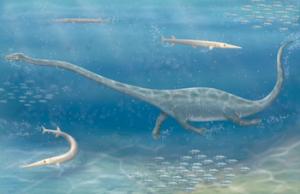Scientists have discovered an ancient long-necked reptile with fangs, seemingly adapted for hunting fish and squid in shallow seas, that existed in the South China Sea over 230 million years ago. This creature had a neck measuring up to 1.7 meters (twice the length of its body) and was quite robust. This finding was published in the journal Science on September 24, 2004.
 |
|
(Image: sciencedaily) |
This species is fully described as a member of a group of reptiles known as Protorosaurs, characterized by their long necks. Comparing this new species with long-necked reptiles and European and Middle Eastern protorosaurs (Tanystropheus) has provided deeper insights into their predatory methods as well as their evolution and diversity during the Triassic period.
Olivier Rieppel from the Field Museum in Chicago noted that while some researchers have commented on the predatory methods of marine predators, this new species may require a reevaluation of how Tanystropheus and other protorosaurs utilized their necks in hunting.
The author Chun Li from the Chinese Academy of Sciences in Beijing discovered this species and named it Dinocephalosaurus orientalis, meaning “the fearsome-headed lizard from the east,” after uncovering a skull measuring 23.5 cm (approximately 9 inches) in the autumn of 2002 in Guizhou province. This skull featured three fangs in the upper jaw, measuring in order from front to back: 1.5 cm, 2.8 cm, and 2.3 cm.
Later that year, in the limestone region of this marine area, Li discovered a nearly complete skeleton of the first protorosaur in China. The skull of this specimen measured 15.5 cm (approximately 6 inches).
Dinocephalosaurus had a relatively short and stout body containing fewer bones than other protorosaurs, indicating a body structure fully adapted to aquatic life. Chun Li suggested that Dinocephalosaurus likely laid eggs on land due to its sturdy body structure, allowing for easy movement on solid ground.
To breathe, Dinocephalosaurus probably kept its neck parallel to the water’s surface because the hydrostatic pressure of the surrounding water hampers lung expansion when it raises its head vertically to take in air.
Both Dinocephalosaurus and Tanystropheus exhibited skeletal structures with ribs extending parallel to the neck, limiting neck movement. The authors proposed that the long neck of Dinocephalosaurus could be used to hunt in two ways:
First, it could launch a surprise attack on prey using its very long neck and small head. Its teeth and fangs were arranged differently than those of other protorosaurs, allowing it to open its jaws similar to the way crocodiles hunt.
Co-author Michael LaBarbera from the University of Chicago proposed a second hunting method. In this method, as Dinocephalosaurus hunted, the neck muscles would contract, rapidly straightening the neck, with its neck tendons spreading out, allowing the throat to expand enough to swallow prey under the pressure generated by the movement of its head. This way, it could execute attacks on relatively large prey in the water.
While it is challenging to add muscles to fossils due to the scarcity or absence of muscular evidence based on fossil studies, Rieppel indicated that his ideas were based on the structure of the bones, mechanical principles, and the complexities of hunting in water—a dense environment that could alert prey well before the predator could attack.
Authors:
Chun Li – Institute of Vertebrate Paleontology and Paleoanthropology, Chinese Academy of Sciences, Beijing.
Olivier Rieppel – Field Museum in Chicago, Illinois;
Michael LaBarbera – University of Chicago in Chicago, Illinois.


















































